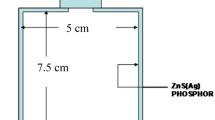Abstract
The concentration of twelve elements—potassium, calcium, manganese, iron, cobalt, nickel, copper, zinc, arsenic, selenium, bromine, and rubidium—in anterior pituitaries from human subjects and rats was measured using Particle Induced X-ray Emission (PIXE). The human material included anterior pituitaries from 37 normal human subjects, 27 males and 10 females, all of whom died from traumatic lesions. Excluded from the investigations were persons with alcohol abuse, regular use of drugs, and babies younger than 1 year.
For selenium, zinc, bromine, and to some extent copper, there was good correlation between the amounts found in anterior pituitaries from rats and human subjects. A significant difference between male and female rat pituitaries was observed for copper, iron, and rubidium, whereas for humans significant difference was only observed for manganese. Anterior pituitaries from human females contained generally more zinc than male glands, but the concentration of zinc in young males was higher than in females. The present study also indicates age related differences in the copper content in anterior pituitaries from human subjects, since pituitaries from humans between 15–45 years contained 25% more copper than those from younger or older persons. The opposite pattern was observed in males. For such elements as Cu, Fe, Mn, and Se, the content in the anterior pituitary from human subjects was 1.6–2 times that stated for other endocrine organs.
Similar content being viewed by others
References
H. L. Fevold, F. L. Hisaw, and R. Greep,Am. J. Physiol. 117, 68 (1936).
P. Petrusz, C. M. Weaver, L. D. Grant, P. Mushak, and M. R. Krigman,Environ. Res. 19, 383 (1979).
H. H. Sandstead, D. N. Orth, K. Abe, and J. Stiel,Clin. Res. 18, 76 (1970).
F. S. LaBella, R. Dular, P. Lemon, S. Vivian, and G. Queen,Nature 245, 330 (1973).
F. Labella, R. Dular, S. Vivian, and G. Queen,Biochem. Biophys. Res. Commun. 52, 786 (1973).
M. Y. Lorenson, D. L. Robson, and L. S. Jacobs,J. Biol. Chem. 258, 8618 (1983).
A. A. Lamperti and R. H. Prinz,Biol. Reprod. 11, 180 (1974).
B. Møller-Madsen and O. Thorlacius-Ussing,Virchows Arch. (Cell Pathol.) 51, 303 (1986).
O. Thorlacius-Ussing, B. Møller-Madsen, and G. Danscher,Exp. Mol. Pathol. 42, 278 (1985).
S. K. Saksena, L. Dahlgren, I. F. Lau, and M. C. Chang,Biology of Reproduction 16, 609 (1977).
G. J. Everson, L. S. Hurley, and J. F. Geiger,J. Nutr. 68, 49 (1959).
A. M. Judd, R. M. MacLeod, and I. S. Login,Brain Res. 294, 190 (1984).
S. K. Mahajan, R. J. Hamburger, W. Flamenbaum, A. S. Prasad, and F. D. McDonald,Lancet ii, 750 (1985).
M. J. Millar, M. I. Fischer, P. V. Elcoate, and C. A. Mawson,Can. J. Biochem. Physiol. 36, 557 (1958).
A. W. Root, G. Duckett, M. Sweetland, and E. O. Reiter,J. Nutr. 109, 958 (1979).
O. Thorlacius-Ussing,Neuroendocrinology 45, 233 (1987).
O. Thorlacius-Ussing and G. Danscher,Toxicol. Appl. Pharmacol. 59, 67 (1985).
O. Thorlacius-Ussing, A. Flyvbjerg, and J. Esmann,Endocrinology 120, 659 (1987).
O. Thorlacius-Ussing, A. Flyvbjerg, and H. Ørskov,Toxicology,48, 167 (1988).
R. I. Henkin,Med. Clin. North Amer. 60, 779 (1976).
T. W. Clarkson, G. F. Nordberg, and P. R. Sager,Reproductive and Developmental Toxicity of Metals, Plenum, New York and London, 1983, pp. 1–205.
G. R. Merriam, L. L. Nunnelley, J. W. V. Trish, and F. Naftolin,Brain Res. 171, 503 (1979).
M. Y. Lorenson and L. S. Jacobs,Excerpta Med. Int. Congr. Ser. 652, 1050 (1984).
E. L. Kanabrochi, J. Greco, L. A. Graham, E. Kaplan, M. E. Rubnitz, Y. T. Oester, S. Brar, P. S. Gustafson, D. M. Nelson, F. Malinari, C. E. Moore, and J. A. Kanabrochi,Int. J. Nucl. Med. Biol. 3, 73 (1976).
T. B. Johansson, R. Akselsson, and S. A. E. Johansson,Nucl. Instr. Meth. 84, 141 (1970).
W. Koenig, F. W. Richter, U. Steiner, R. Stock, R. Thielman, and U. Wätjen,Nucl. Instrum. Meth. 142, 225 (1977).
G. I. Johansson,X-ray Spectrometry 11, 194 (1982).
N. Hertel,Nucl. Instr. Meth. B 14, 58 (1986).
W. J. Dixon,BMDP Statistical Software, University of California Press, Berkeley, 1983.
S. A. E. Johansson and T. B. Johansson,Nucl. Instr. Meth. 137, 473 (1976).
N. Hertel and O. Thorlacius-Ussing,Nucl. Instr. Meth. B 22, 149 (1987).
G. W. Iyengar, W. E. Kollmer, and H. J. M. Bowen,The Elemental Composition of Human Tissues and Body Fluids, Verlag Chemie, Weinheim, New York, 1978.
H. J. M. Bowen, inTrace Elements in Biochemistry, H. J. M. Bowen, ed., Academic, London, 1966, pp. 61–84.
E. I. Hamilton, M. J. Minski, and J. J. Cleary,Sci. Total Environ. 1, 341 (1972/1973).
N. Ishinishi, K. Tsuchiya, M. Vahter, and B. Fowler, inHandbook on the Toxicology of Metals, 2nd ed., L. Friberg, G. F. Nordberg, and V. Vouk, eds., Elsevier, Amsterdam 1986, pp. 43–83.
S. K. Mahajan, A. A. Abbasi, A. S. Prasad, P. Rabbani, W. A. Briggs, and F. D. McDonald,Ann. Intern. Med. 97, 357 (1982).
Author information
Authors and Affiliations
Rights and permissions
About this article
Cite this article
Thorlacius-Ussing, O., Gregersen, M. & Hertel, N. The concentration of twelve elements in the anterior pituitary from human subjects and rats as measured by particle induced X-ray emission (PIXE). Biol Trace Elem Res 16, 189–202 (1988). https://doi.org/10.1007/BF02797135
Received:
Accepted:
Issue Date:
DOI: https://doi.org/10.1007/BF02797135




